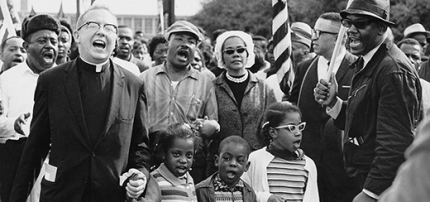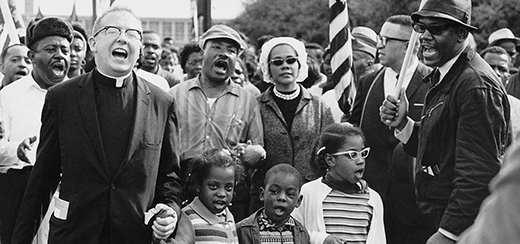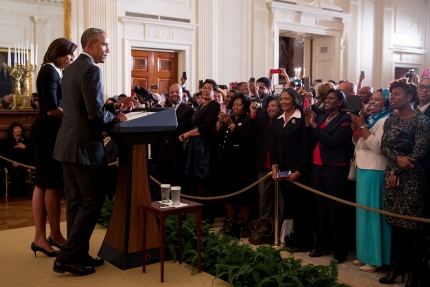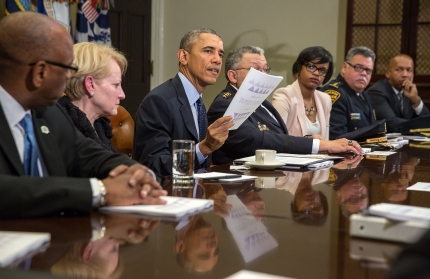Blog Posts Related to the African American Community
President Obama Marks the 50th Anniversary of the Marches from Selma to Montgomery
Posted by on March 8, 2015 at 4:44 PM EDTYesterday, President Obama and the First Family joined thousands of Americans at the foot of the Edmund Pettus Bridge in Selma, Alabama, to honor the sacrifice and bravery of the men and women who bled there, on that very pavement exactly 50 years ago. Many of those original "foot soldiers" joined him yesterday, including Congressman John Lewis, who helped to organize the first march over this bridge in 1965, who endured a tragic beating on that "Bloody Sunday," and who yesterday strode arm in arm with the President of the United States.
It was a day filled with electricity, inspiration, tales of heartache and courage, and the true story of how a handful of ordinary Americans helped to change the course of history with their grace, their peaceful action, and their bold belief in the true spirit of this country.
Learn more about Civil RightsSelma to Montgomery: 50 Years Later
Posted by on March 6, 2015 at 7:25 PM EDTFifty years ago, in March of 1965, thousands of Americans marched from Selma, Alabama to the capital city of Montgomery. They marched to ensure that African Americans could exercise their constitutional right to vote -- even in the face of a segregationist system that wanted to make it impossible.
Many of them were beaten, bloodied, and knocked unconscious at the hands of state troopers and county members. But they kept marching.
Because of their efforts, Congress passed the Voting Rights Act just a few months later. The Voting Rights Act was designed to eliminate legal barriers at the state and local level that prevented African Americans from exercising their right to vote -- after nearly a century of unconstitutional discrimination.
To mark the 50th anniversary of the marches, the First Family will travel to Selma tomorrow, with President Obama delivering remarks on the Edmund Pettus Bridge. Tune in tomorrow afternoon to watch the President's remarks live at WhiteHouse.gov/Selma -- a new interactive page that also features additional content related to the marches.
Learn more about Civil RightsHonoring the African American Experience: The White House Celebrates Black History Month
Posted by on March 3, 2015 at 1:05 PM EDTIn 1926, the great historian and author Carter G. Woodson pioneered "Negro History Week" — a time set aside to honor African Americans and their contributions to our history.
"If a race has no history, it has no worthwhile tradition," Woodson once wrote. "It becomes a negligible factor in the thought of the world, and it stands in danger of being exterminated."
That week would later become Black History Month — and this year, the White House hosted a number of events and activities to celebrate the contributions and the accomplishments of African Americans both past and present.
Learn more aboutWhat 21st Century Policing Means
Posted by on March 2, 2015 at 5:16 PM EDTEarlier today, President Obama met with the Task Force on 21st Century Policing to discuss their recommendations to help communities and law enforcement agencies across the country to strengthen trust and collaboration, while continuing to reduce crime.
The Task Force was announced in December, and has been co-chaired by Philadelphia Police Commissioner Charles Ramsey and former Assistant Attorney General Laurie Robinson. Joining them on the Task Force is a diverse array of experts from the law enforcement community, academia, youth activists, as well as community and civil rights leaders. Their recommendations for helping to keep police officers and neighborhoods safe were released today, as called for by the Executive Order that established the Task Force.
Learn more about Civil RightsCelebrating Black History Month Across the Cabinet
Posted by on March 2, 2015 at 4:34 PM EDT
Throughout February, a number of Departments and Cabinet Secretaries held special events and participated in activities to commemorate Black History Month. Take a look at a few of the highlights below.
Secretary Perez sat down with Rep. John Lewis to talk about the Civil Rights Movement.
Last Friday, Labor Secretary Tom Perez and Rep. John Lewis sat down for an in-depth conversation and Q&A about the Civil Rights Movement, as well as the Department of Labor’s role in the movement.
Watch some of the highlights of the conversation below -- or listen to the full conversation here.
Learn more aboutToday: Join Us for Our First STEM Heroes Edit-a-thon
Posted by on February 24, 2015 at 3:45 PM EDTU.S. Chief Technology Officer Megan Smith just sent the following message to the White House email list, promoting our first "edit-a-thon" here at the White House. This afternoon at 5 p.m. ET, we'll be writing the stories of influential African American STEM leaders into history.
Get more details below -- and if you didn't get the email, make sure to sign up for email updates here.
In a few hours, we'll be hosting the first-ever "edit-a-thon" here at the White House as part of our celebration of Black History Month.
Today, we join others in working to raise visibility of past and living African American heroes through similar edit-a-thons, classroom activities, and on social media.
Katherine Johnson, an elite mathematician, was central in calculating the trajectories for John Glenn, Alan Shepard, and the Apollo 11 mission. Lewis Howard Latimer was recruited to join the Edison Electric Light Company after Latimer patented his "process for manufacturing carbons," allowing the company to improve production of carbon filaments used in light bulbs upgraded from the earlier paper-based filaments that burned out quickly. Earlier, Latimer worked as Alexander Graham Bell's draftsman and is credited with penning the drawings in Bell's telephone patent.
It's critically important to know about all of the talented people who have been a part of advancing culture and society throughout America's history.
Together, we can help make sure these nearly lost histories are captured for our youth. Today's event will focus on African American heroes in science, technology, engineering, and math (STEM).
At 5:00 p.m. ET, join us online:
Learn more about Technology
- &lsaquo previous
- 1
- 2
- 3
- 4
- 5
- 6
- 7
- 8
- 9
- …
- next &rsaquo



